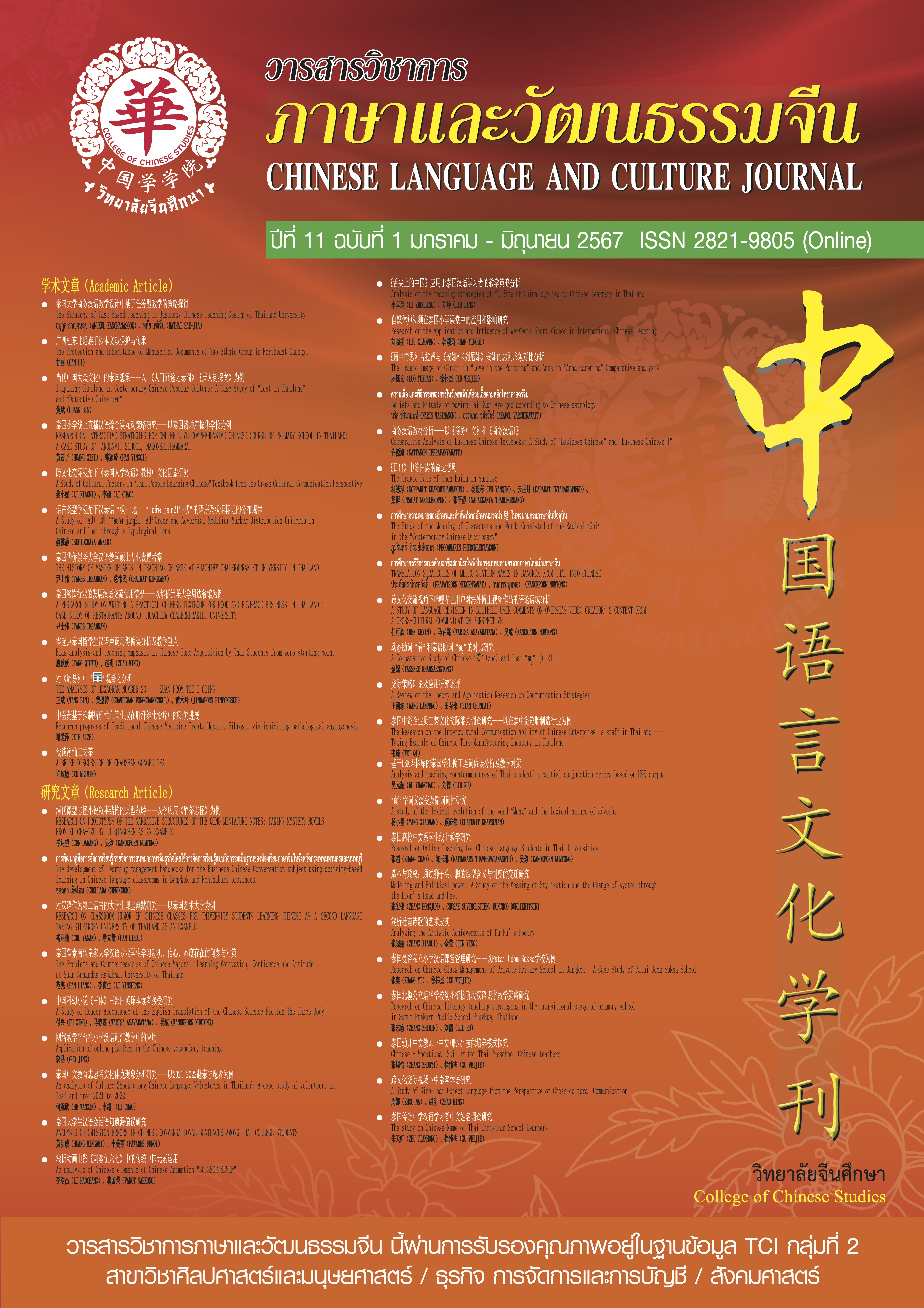RESEARCH ON CLASSROOM HUMOR IN CHINESE CLASSES FOR UNIVERSITY STUDENTS LEARNING CHINESE AS A SECOND LANGUAGE TAKING SILPAKORN UNIVERSITY OF THAILAND AS AN EXAMPLE
Keywords:
Humor, Chinese, Second Language, Classroom Teaching, Humor StrategyAbstract
Humor is an effective method used in a variety of educational settings, but its use in university contexts where Chinese is taught as a second language has not been adequately studied. The purpose of this study is to find out how humor is used in Thai university classrooms of spoken Chinese, to explore what types of humor are used in Thai classrooms of spoken Chinese, and to analyze the mechanisms by which it is generated, and on this basis to identify effective humor strategies that can be used to increase student engagement, motivation, willingness to communicate, and learning outcomes.
The author used a qualitative research design to collect data through classroom observations and questionnaires and used thematic analysis to analyze the data using a sampling of spoken Chinese classrooms at the University of the Arts in Thailand. The results show that the types of humor in the classroom of college students of Chinese as a second language are mainly verbal humor, body language, and humorous props. The characteristics of the above humor are: 1) mostly related to the course learning content; 2) mostly episodic; 3) context specific; 4) related to the students' language ability level. The mechanisms of classroom humor include the humor of the course content, the teacher's own sense of humor, the creation of classroom atmosphere, the bridge effect, and the students' personal characteristics. The functions of classroom humor are mainly manifested in enlivening the classroom atmosphere, triggering pleasant emotions, reducing learning anxiety and willingness to express it, stimulating the willingness to communicate in class, and contributing to the establishment of good teacher-student relationships. The study also found that humor may be culturally and contextually specific and that teachers need to consider students' cultural backgrounds and language proficiency levels when using humor in the classroom.
In conclusion, this study contributes to the understanding of the role of humor in second language acquisition and teaching and provides practical guidelines for language teachers to use humor effectively when teaching Chinese as a second language in universities. The findings will also provide information about students' and teachers' attitudes toward humor use, help language teachers and researchers develop more effective methods of teaching Chinese as a second language, and provide guidance for the development of language teaching theories that integrate humor as an effective teaching tool.
References
鲍沈阳.科学课堂上的笑声:基于社会建构主义理论的互动分析[D].华东师范大学硕士学位论文,2022.
陈越.汉语幽默的特点及在对外汉语教学中的应用[D].华中师范大学硕士学位论文,2014.
程朝霞.论语文教师的教学幽默[D].湖南师范大学硕士学位论文,2006.
定梦君.教师幽默在高中英语教学中的使用研究[D].华中师范大学硕士学位论文,2014.
刘苹.言语幽默的语言学研究综述[J].湘潭大学学报(哲学社会科学版),2005,(S2):152-154.
史玉婕.中式幽默的语言学解读及其在对外汉语教学中的应用研究[D].山东师范大学硕士学位论文,2022.
孙菲雨.高中英语课堂教师幽默话语研究[D].长春师范大学硕士学位论文,2015.
孙绍振.论幽默逻辑的二重错位律[J].文学评论,1996,(05):78-86.
王玲玉.对泰华裔汉语教学中的课堂幽默语言调查研究[D].广西师范大学硕士学位论文,2019.
王牧群、李相敏.英语幽默话语的谬误和诡辩及其语用功能[J].外语学刊,2007,No.138(05):67-70.
王坛.幽默研究综述[J].大学英语(学术版),2006,(02):93-97.
王一琼.外语教师专业化及课堂幽默语用教学模式的培养[J].林区教学,2017,No.246(09):58-59.
尉万传.当代西方幽默研究的语言学转向及趋势[J].外语教学,2015,36(05):21-25.
徐芳.关于教师构建幽默课堂的几点思考[J].湖北经济学院学报(人文社会科学版),2012,9(07):156-157.
徐校雪.对外汉语教学中的教师幽默话语研究[D].江西师范大学硕士学位论文,2016.
姚燕.高职英语课堂幽默策略研究[J].教育教学论坛,2016,No.257(19):237-238.
袁彩虹.语言变异的幽默效果[J].洛阳师范学院学报,2002,(04):114-115.
岳月霞.课堂幽默与英语教学[J].文学教育(中),2012,(01):80.
张佳丽.教师教学幽默的生成研究[D].西南大学硕士学位论文,2020.
张金.中学语文阅读教学课堂幽默研究[D].山东师范大学硕士学位论文,2022.
Berk RA.Student ratings of 10 strategies for using humor in college teaching[J]. Journal Of Excellence in College Teaching,1996.
Bushnell C. “Lego my keego!”: An analysis of language play in a beginning Japanese as a foreign language classroom[J]. Applied Linguistics, 2008,30(1):49-69.
Cann A.and Etzel K. Remembering and anticipating stressors: positive personality mediates the relationship with sense of humor[J]. Humor, 2008,21(2):157-178.
Check J. Humor in education[J]. Physical Educator, 1997,54(3):165-167.
Gorham J.and Christophel D. Students’Perception of Teacher Behaviors as Motivating and Demotivating Factors in College Classes[J].Communication Quarterly,1992,(40): 239-252.
Hayashi T.,Urayama O., Hori M., Sakamoto S., Kawai U.and Murakami, K. Laughter modulates
prorenin receptor gene expression in patients with type 2 diabetes[J]. Journal of Psychosomatic Research. 2007,62(6): 703-706.
Henzel Embalzado,Pair Sajampun.Perspectives of Students in Thailand on the Use of Humor in University Classroom[J].International Education Studies,2020,13(4).
John Robert Schmitz. Humor as a pedagogical tool in foreign language and translationcourses[J]. Humor - International Journal of Humor Research,2002,15(1).
Meksophawannagul M. Teacher and learner views of effective English teaching in the Thai context: The case of engineering students[J]. English Language Teaching,2015, 8(11):99-116.
Poirier T. I.and Wilhelm M. Use of humor to enhance learning: bull’s eye or off the mark. American journal of pharmaceutical education[J].2014,78(2).
Pomerantz A. and Bell N. D. Humor as safe house in the foreign language classroom[J]. The Modern Language Journal, 2011,95(s1), 148-161.
Waring H. Z. Doing being playful in the second language classroom[J]. Applied Linguistics, 2013,34(2):191-210.
Downloads
Published
How to Cite
Issue
Section
License
Copyright (c) 2024 Chinese Language and Culture Journal

This work is licensed under a Creative Commons Attribution-NonCommercial-NoDerivatives 4.0 International License.
บทความที่ได้รับการตีพิมพ์เป็นลิขสิทธิ์ของวารสารภาษาและวัฒนธรรมจีน มหาวิทยาลัยหัวเฉียวเฉลิมพระเกียรติ
บทความใน “วารสารวิชาการภาษาและวัฒนธรรมจีน” เป็นทรรศนะของผู้เขียนโดยเฉพาะ กองบรรณาธิการไม่มีส่วนในความคิดเห็นในข้อเขียนเหล่านั้น




